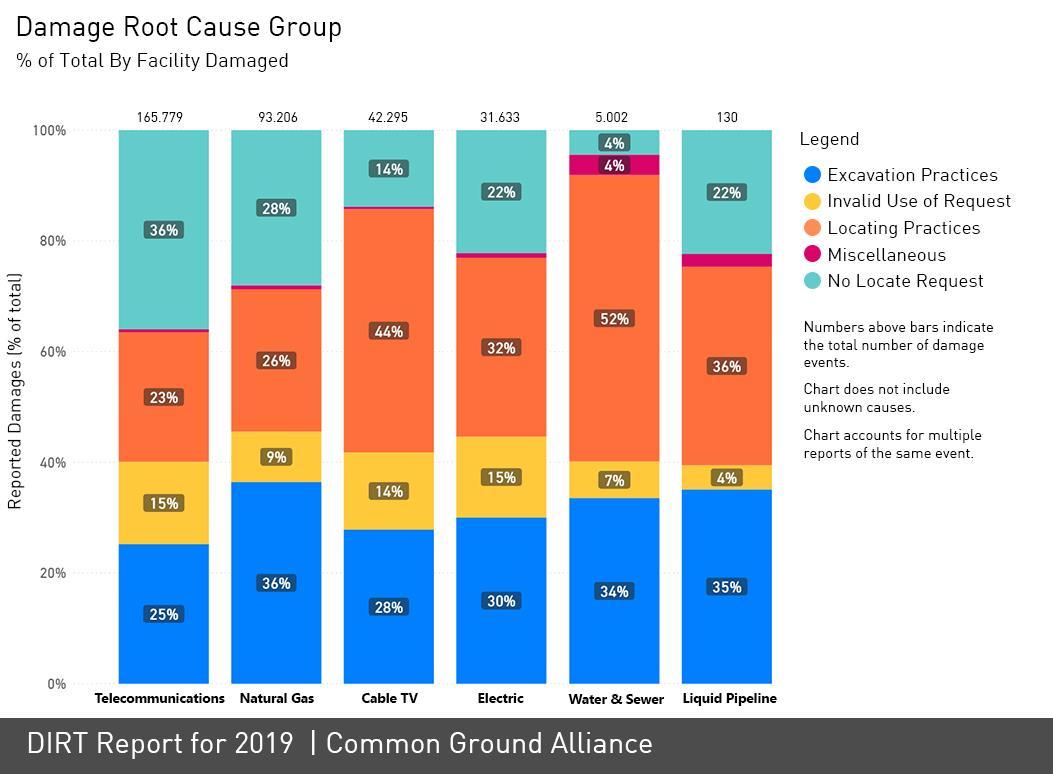
11 minute read
Examining Root Causes
The main DIRT root cause groups are equalizing in terms of their contributions to the total number of damages, indicating that systematic improvements need to occur across the damage prevention process. It is important to distinguish between damage liability and true damage root causes in order to accurately identify where changes in behavior could lead to changes in outcomes. Failing to notify the one call center (No Locate Request) remains the single largest individual root cause of damages at 29.1%, followed by excavator failing to maintain clearance (16.7%) and facility marked inaccurately due to locator error (10.6%).
Root Cause by Group
Table 4— Reported damages by root cause for 2019 (color coded by root cause group) The Data Committee sorts these 26 individual root causes into 6 groups to provide a high-level snapshot of what went wrong in the damage prevention process.
DIRT has 26 individual root causes to choose from (including Root Cause Not Listed AKA Unknown/Other). Table 4 lists the 25 known individual root causes for 2019 damage events sorted high-to-low and colorcoded to match subsequent figures based on root cause groups. The % of Total column in Table 4 excludes “Not Listed” and “Unknown” root causes (109,538).
No Locate Request represents damages caused by the failure to notify. 3 Invalid Use of Request4 captures situations where the excavator invalidates the ticket by commencing work too early or digging beyond the expiration date or outside the work area described on the ticket. It also covers scenarios where the excavator information to the one call center in the initial notification. provided incorrect
Excavation Issue captures damages where something went wrong in the physical digging process. Locating Issue captures damages caused by inaccurate or uncompleted marking. Miscellaneous captures damage causes that do not fit into a notification, locating or excavating category. These consist of deteriorated facilities, previous damage and one call center error. These typically account for around 1% of damages combined. Unknown/Other captures damages where the root cause was not collected or none of the available choices fit. When this is selected, the DIRT system requires5 the user to also provide a free-text comment. Ideally this would be something relevant and useful, providing some indication of what caused the damage and why none of the available root cause choices fit.
The first three root cause groupings above – No Locate Request, Invalid Use of Request and Excavation Issue – are the responsibility of excavators, and can be generally aligned to the five-step safe excavation process geared to the contractor audience: https://call811.com/Start-Here/Contractors.

3 Notification Not Made is singled out—making it a group of one—because it has historically been the single leading root cause and because it is the focal point of 811 and Call Before You Dig awareness. 4 In previous DIRT reports these were referred to as “Other Notification Practices.” 5 This comment field is optional when any other root cause is selected.
Figure 5 shows the major root cause groupings for 2015 through 2019, excluding unknown root causes. The DIRT root causes were revamped starting in 2018. Prior to that, abandoned facilities were grouped with Miscellaneous root causes. Abandoned facilities are now grouped with Locating Practices and are presented that way in Figure 5 for the entire graph. Moving abandoned facilities out of the Miscellaneous group leaves the total for the remaining Miscellaneous root causes negligible, and they are also filtered out of Figure 5. The revamping also contributed to the decrease in Excavating Practices and roughly corresponding increase in Invalid Use of Request at the 2017-2018 transition.6 With these adjustments, Figure 5 allows us to visualize trends in root cause groups over the past five years. In 2019, the No Locate Request, Excavating Practices and Locating Practices root cause groupings are converging toward approximately equal, with the impact of Invalid Use of Request also becoming more focused.
Figure 5

6 The 2018 DIRT Report explains 2018 root cause revisions in greater detail.
The Importance of Separating Liability from Root Cause in DIRT Data
Root Cause is defined, for DIRT purposes, as the point where a change in behavior would reasonably be expected to lead to a change in the outcome (i.e., avoidance of the event). Many DIRT users utilize their damage/repair claims information as their DIRT data source and attempt to match their internal codes to an available DIRT root cause selection. Thus, their primary concern is not what would have avoided the damage, but rather who is going to pay for it. Take for example a damage that occurs on day 31 in a location with a 30-day life-of-ticket. If the marks are still visible, but inaccurate, from a pure root cause perspective it should be considered a locating issue. If the marks are still visible and accurate, the pure root cause could be an excavating issue such as failure to pothole or failure to maintain clearance. In this example, a facility operator may be justified in billing an excavator for repairs, but Excavator dug after valid ticket expired is more a technicality than a pure root cause.
The same dynamics could apply in a case of ticket “piggy-backing,” which is when an excavating company relies on the marks from another contractor working at the same site.7 If the excavator involved in the damage does not match the name on a one call ticket for the site, the facility owner/operator (or locator) would likely report it in DIRT with a root cause of No notification to one call center/811, regardless of what a deeper root cause analysis might find. These are examples where an excavator and locator/facility operator may both submit DIRT reports on the same event with conflicting root causes, yet both have truthful elements.
It is unrealistic to expect facility operators to keep one set of records for damage claims and another for DIRT. Having Invalid Use of Request root cause options available in DIRT gives DIRT users a home for some of these events and gives the Data Committee something to work with, which is preferable to having them hidden in a “not listed” category. At the same time, there may be some reports with pure locating and excavating root causes hidden in the Invalid Use of Request group. There may also be instances where the excavator did wait but the locate was unreasonably delayed and the excavator commenced work, meaning there could be some Facility not marked due to no response from operator/contract locator hidden in there as well.
We will next look at trends within each of the damage root cause groups over recent years.
7 Best Practice 5.6 calls for every excavator on the job site to have a separate one call ticket.
No Locate Request (NOTIFY)
Figure 6

The percentage of damages due to No Locate Request has been trending upward for three consecutive years, despite call-before-you-dig awareness reaching an all-time high.
Invalid Use of Request (WAIT / CONFIRM)
Due to the vagueness of the root cause descriptions available prior to 2018, DIRT users were often categorizing situations as Improper Excavation Practice Not Listed Elsewhere or Root Cause Not Listed Elsewhere. 8 The revised root causes give DIRT users clearer options for situations that are now grouped under Invalid Use of Request, but complicates trending across the 2017-2018 transition period. Instead we show the two years following the transition in Figure 7, which indicates consistency over the period.
Excavator dug before valid start date/time stands out as the leading cause within this group. This is followed by Excavator dug after valid ticket expired and Excavator dug outside area described on ticket, which are approximately equal. The 2018 root cause revisions provide increased clarity on invalid use of locate requests, particularly to how often the WAIT step of the damage prevention process is not followed.
Figure 7
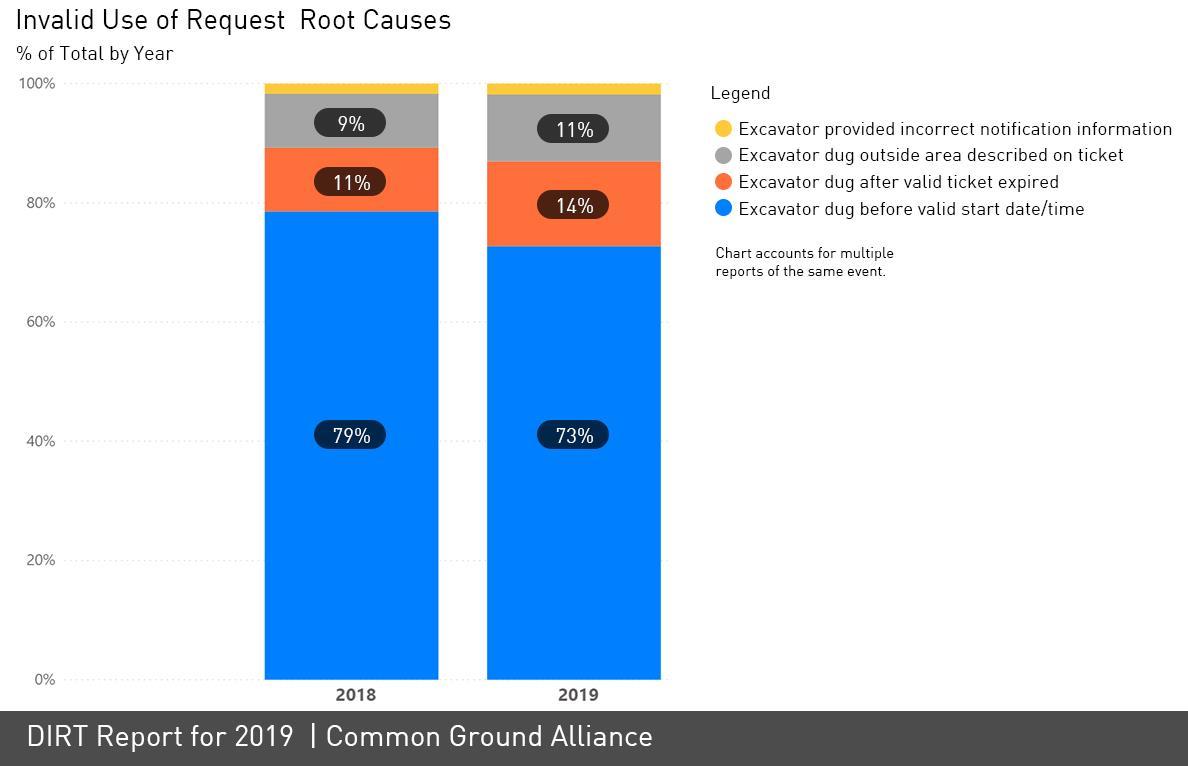
8 Based on comments in the free-text field for unknown/other root causes.
Excavating Practices Root Cause Group (RESPECT / DIG CAREFULLY)
Figure 8 depicts the individual root causes that make up the Excavating Practices group. Up to the end of 2017, Failure to use hand tools where required was included as a DIRT option. It was removed as part of the 2018 DIRT revisions. The rationale was that “where [hand tools are] required” is while potholing and/or while digging in the tolerance zone. Those situations are already covered by Excavator dug prior to verifying marks by test hole (pothole) and Excavator failed to maintain clearance after verifying marks. It appears that DIRT users tended to shift back and forth between utilizing Failure to pothole, Failure to maintain clearance, and up to 2017—Failure to use hand tools where required to describe interrelated root causes, which all have to do with the DIG CAREFULLY step. To streamline the fluctuations among these three root causes, Figure 8 combines them (Clearance/Pothole/Handtool). This highlights the contribution of these root causes to total damages and indicates they should be addressed as a package.
Figure 8
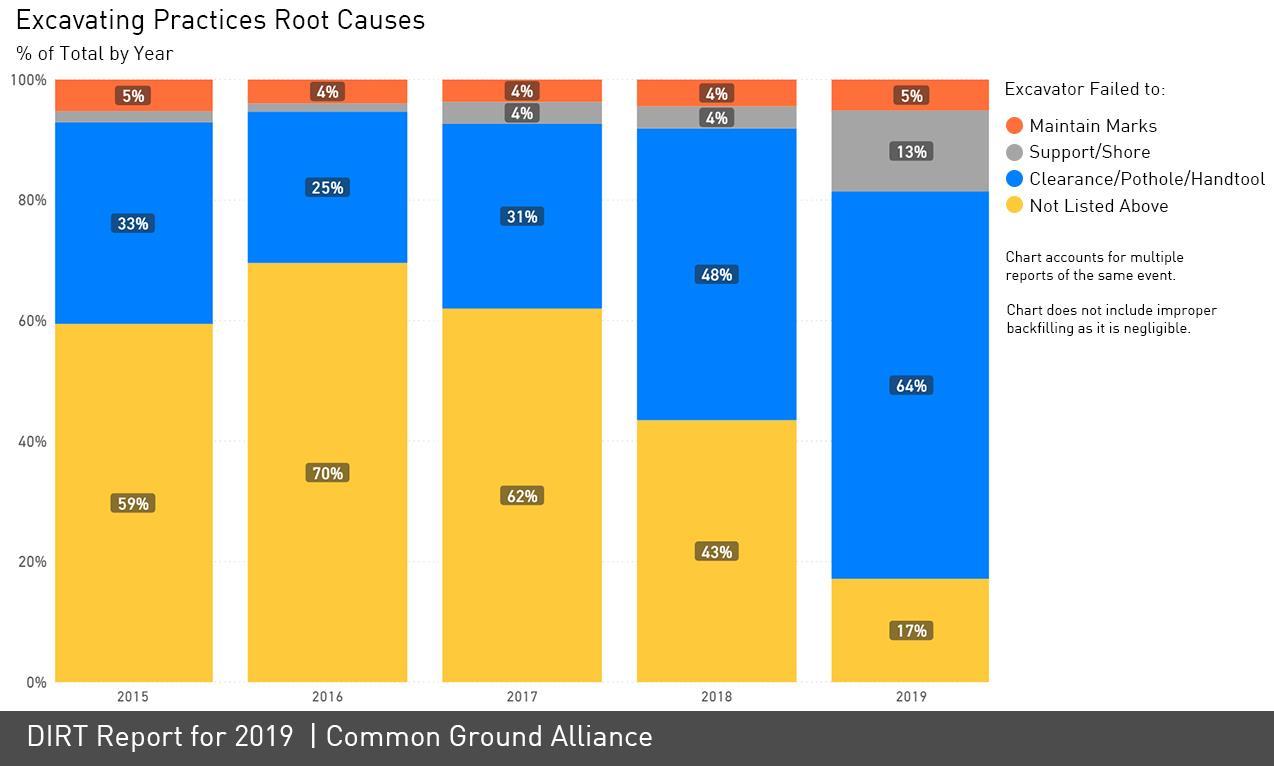
Improper Excavation Practice Not Listed Elsewhere (Not Listed Above (yellow) in Figure 8) is intended as a catch-all when a more specific excavating root cause is not captured. There are likely a significant number of Failure to pothole, Failure to maintain clearance and Failure to use hand tools where required events hidden in the blue of Figure 8. The individual root causes in the Excavating Practices group for 2019 are shown in Figure 9.
Figure 9
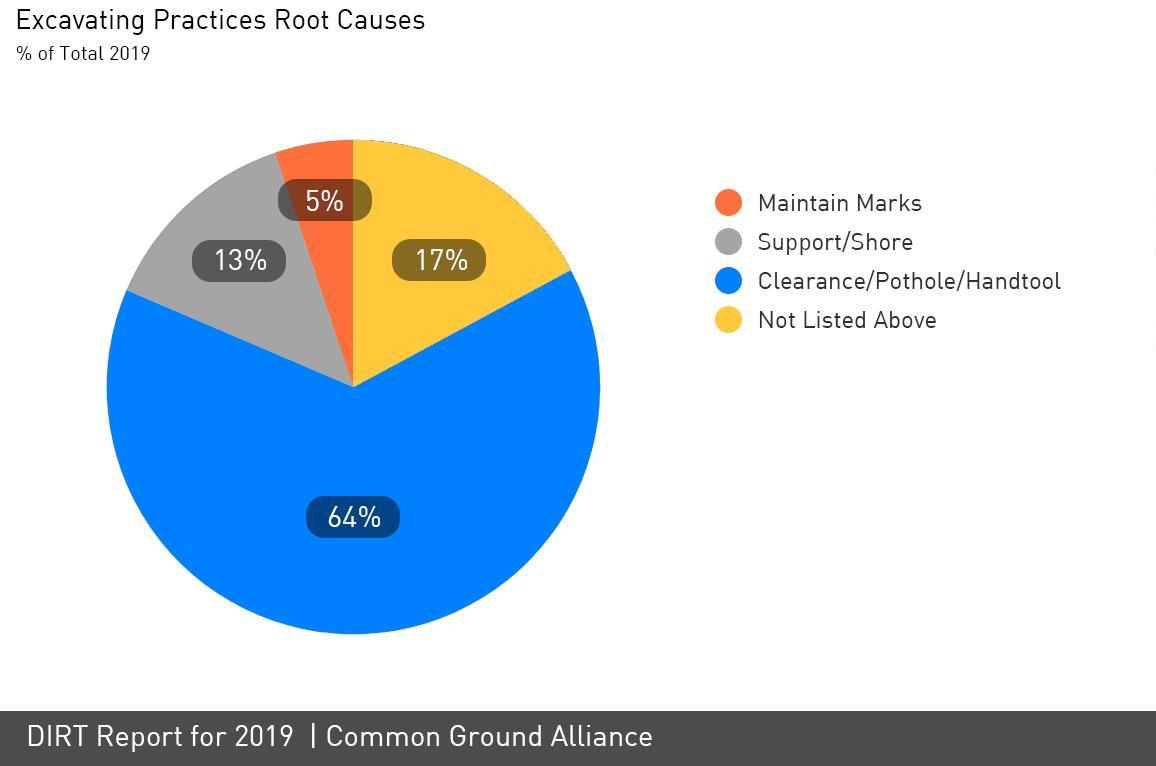
Locating Practices Root Cause Group Trends
Through 2017, DIRT listed four individual locating practice root causes: • Facility could not be found or located • Facility marking or location not sufficient • Facility was not located or marked • Incorrect facility records/maps
Locating Practices was the root cause group most affected by the 2018 revisions to the DIRT form. The first three root causes bulleted above were eliminated for 2018 DIRT data submissions because they were vague and indistinguishable. In their place, specific root causes were added, such as Tracer wire issues, No response from the operator/contract locator and Locator error. The 2018 revisions also attempted to distinguish between marks being present-but-inaccurate, versus not being present at all.
The DIRT form now lists eleven possible individual locating root causes. Incorrect facility records/maps translates most directly from the 2017 to 2018 version, although now with two variations: Marked inaccurately and Not marked at all. In addition, Abandoned facilities was moved from Miscellaneous to the Locating group, again with separate options for inaccurate and not marked. The first three items from the 2017 list above are now scattered among the other seven locating root causes.
Two new root causes involving locator error were introduced in 2018: One for marked-but-Inaccurate and one for not marked. These are intended as a catch-all for when a more specific root cause is not known. For example, an excavator may only know that marks are inaccurate, while a locator or facility operator may be better able to determine if it was a mapping, tracer wire, or abandoned facility issue. There may be damages relating to mapping, tracer wire and abandoned facility hidden in the locator error category. Therefore, such errors should not always be interpreted to conclude that the technician is the responsible party. Inaccurate maps, broken tracer wire, abandoned facility, etc. could lead to an inaccurate locate even if the locator followed all proper procedures.
Finally, it is apparent that some DIRT users are not yet distinguishing between Inaccurate marks as opposed to not marked, but are combining them all together, usually under marks-present-butinaccurate. These changes make navigating the 2017 to 2018 transition a challenge. Therefore, to simplify the analysis and help identify like areas of focus across the time period, we add together the marked-butinaccurate and not-marked for locator error, Abandoned facilities, Incorrect maps/records, Incomplete marks, and Unlocatable facilities. The result is Figure 10.
Figure 10—Locating root causes for 2015 to 2019
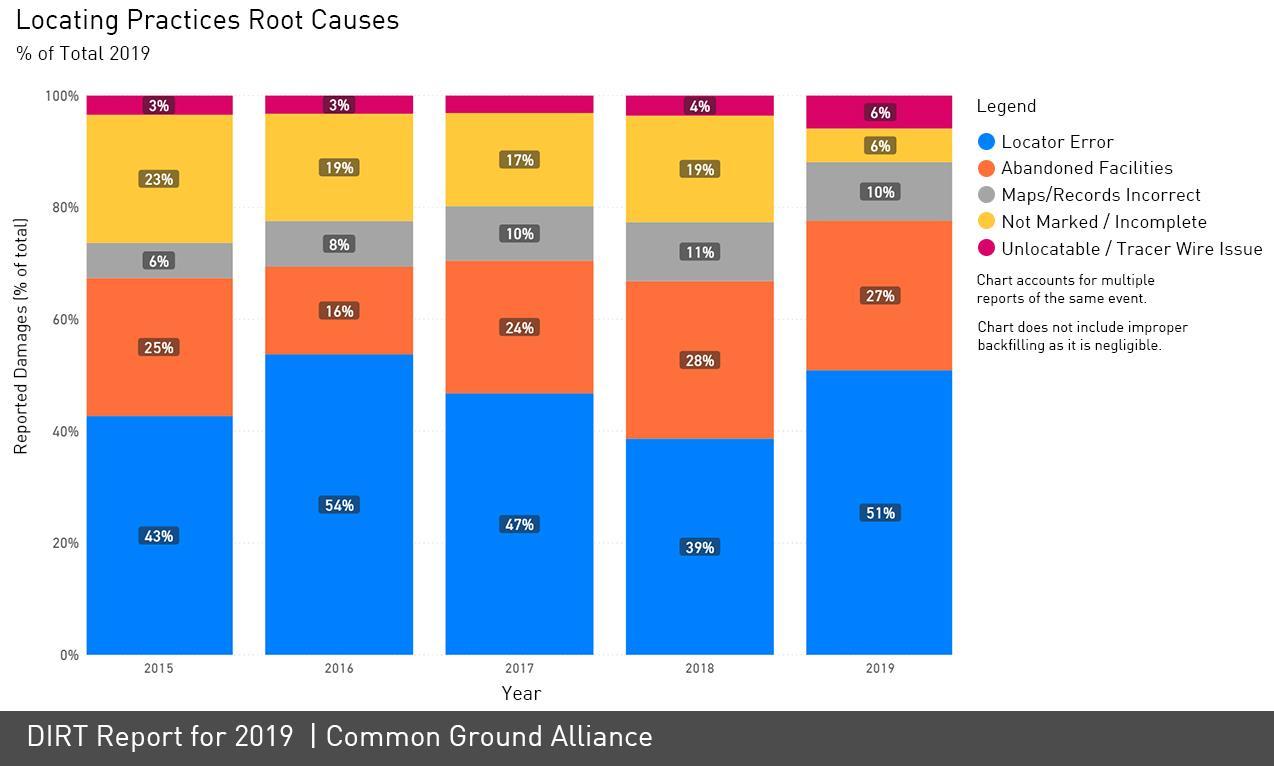
Locator error is the leading locating root cause for 2019, but as discussed above, it likely includes some combination of other more specific locating root causes. Abandoned facilities are included in the Locating Practices group for all years depicted in Figure 10 and stand out as a significant contributor.
Figure 11 shows the individual locating root causes for 2019.

Figure 11
Root Cause Group by Event Source
Figure 12 shows some significant differences in the root cause group percentages by event source, although the number of total damages per event source should be considered when interpreting the graph. For instance, the 80 “Other” reports came from Equipment Manufacturers, Engineer/Design and Railroad stakeholders and are likely too small to draw any solid conclusions. Excavators/Road Builders report the highest percentage (69%) of Locating Practices. It should also be noted that unknown root causes data is filtered out in Figure 12. If unknown root causes were included, they would account for 65% of Excavators’ and Road Builders’ reports and drop Locating Practices to 24%.
Figure 12
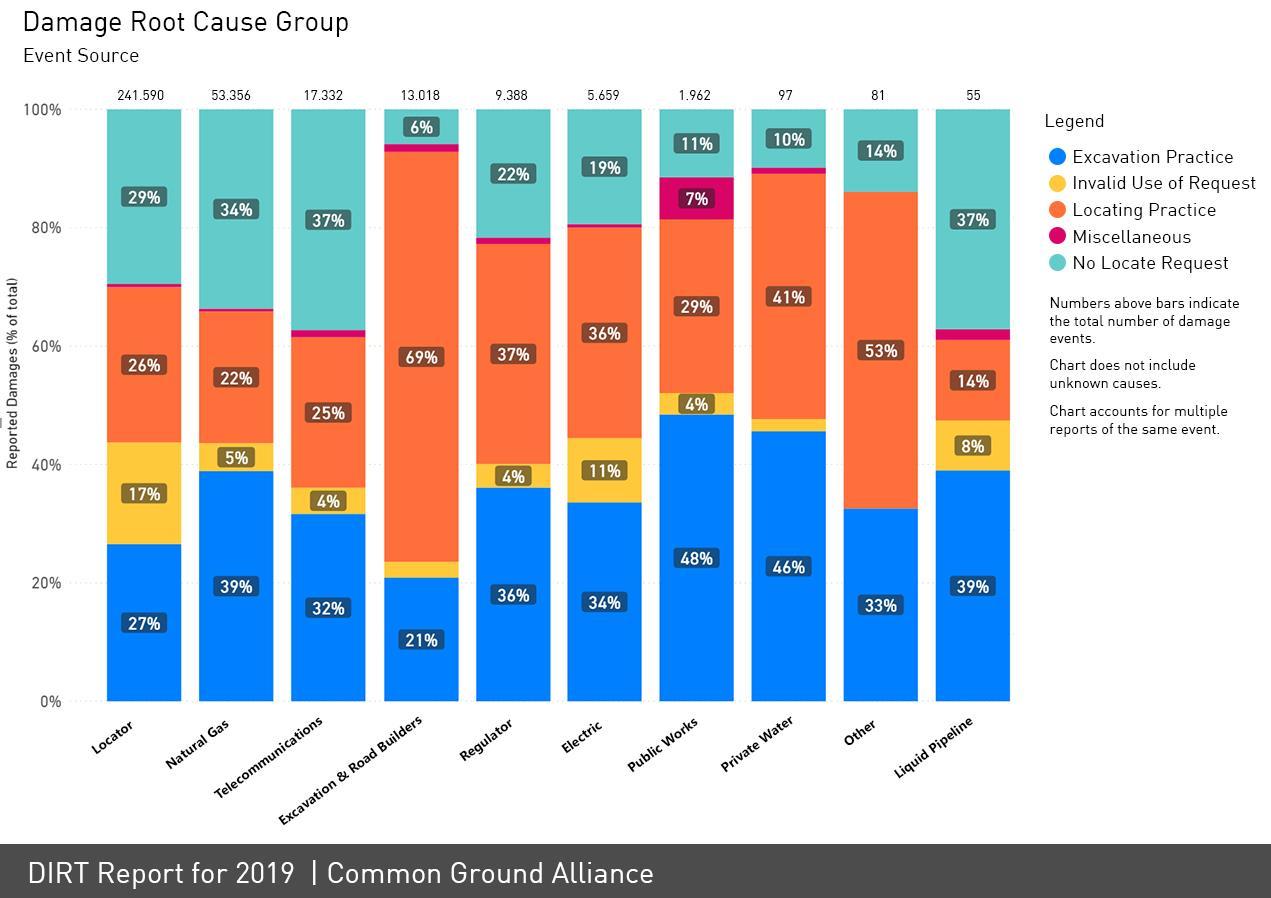
Excavator Type by Root Cause
Figure 13 shows the root cause groups by type of excavator involved. As can be seen in the figure, the leading cause of damages for occupants is No Locate Request, while for most other excavator types it is Locating Practices.
Figure 13
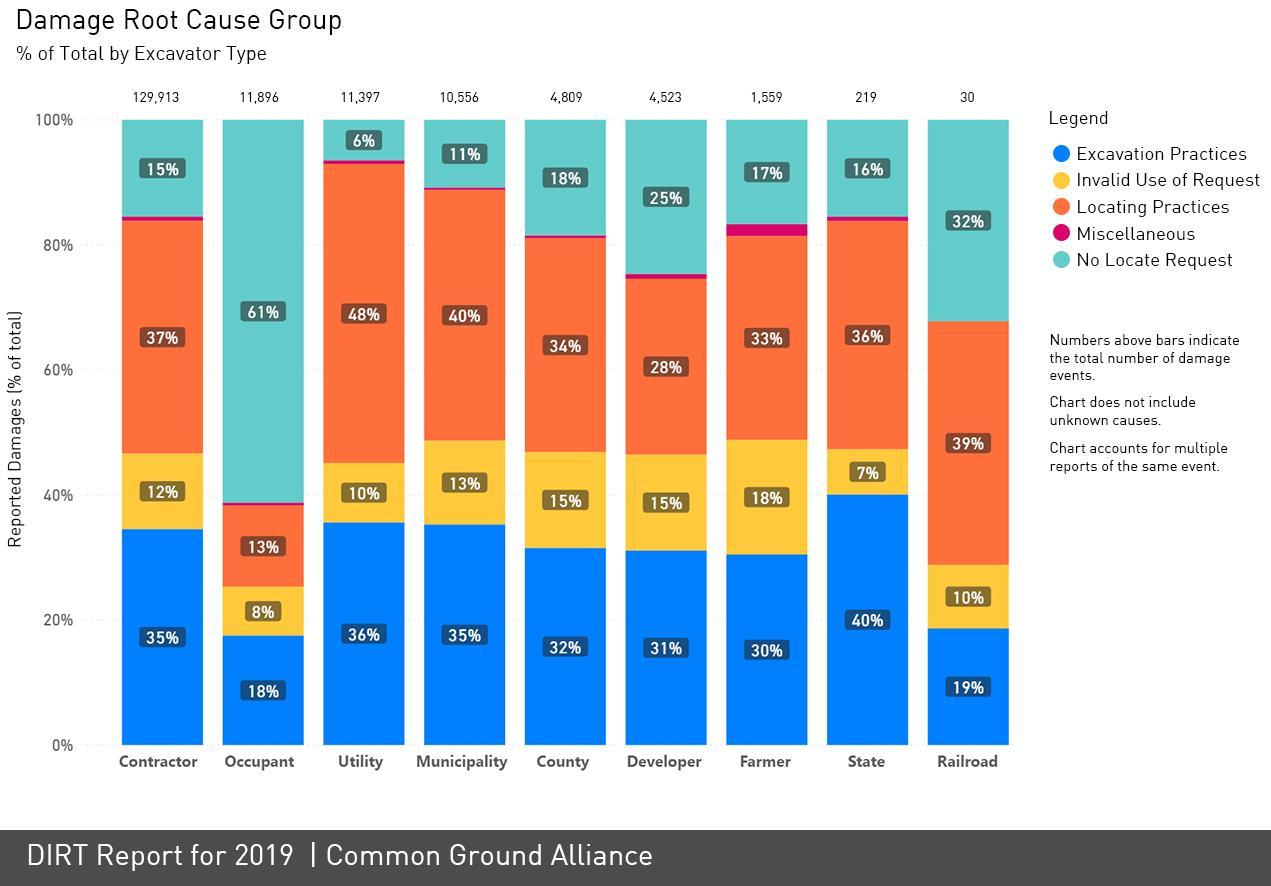
Facilities Damaged by Root Cause
Figure 14 demonstrates the relationship between damaged facilities and root cause.
Figure 14
